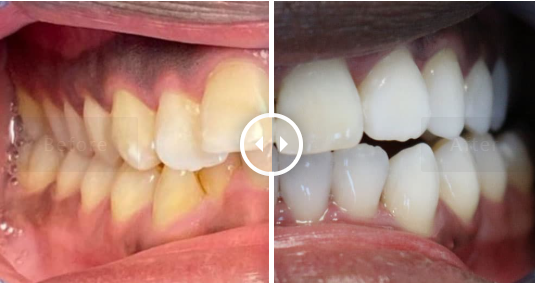What are Composite Dental Front Tooth Filling?
Composite resin fillings, also known as tooth-colored cavity on front tooth, are used to seal the gaps or cavities in your teeth caused by dental decay or bacterial infections. Composite dental fillings offer strong durability for small to medium-sized cavities, capable of withstanding bite force. Composite dental fillings are the ideal choice for patients seeking natural-looking, tooth-colored restorations.

What Are the Different Types of Front Tooth Fillings?
The following are the five types of front tooth fillings you should be aware of:
- Amalgam Fillings: Amalgam fillings are some of the strongest and most durable fillings, but they’re also the most visible. They’re usually made of an amalgamation of different metals, such as mercury, silver, copper, etc. Amalgam fillings are usually placed on some of the posterior teeth because they’re not tooth-colored but can withstand the immense bite force generated in the molars.
- Composite Fillings: As mentioned previously, composite fillings are also known as tooth-colored fillings because they can be made to match the color of your other teeth. They’re ideal for small- to medium-sized cavities, and they can only handle mild-to-medium bite force, making them suitable for the front teeth but not the back teeth.
- Metallic Fillings: Metallic fillings are usually amalgams of gold and silver, and they can last 10 to 15 years. They’re highly visible, but they’re stronger and more long-lasting than tooth-colored fillings.
- Ceramic Fillings: Ceramic or porcelain fillings are also natural-looking and tooth-colored fillings. However, unlike composite fillings, they’re also stainless and don’t reveal stains. However, ceramic fillings are as expensive or more expensive than gold fillings.
- Glass Ionomer Fillings: Glass ionomer is a special combination of acrylic and glass, and it releases fluoride into the teeth to protect them from bacterial infections. However, glass ionomer fillings aren’t as durable as other types of fillings.
How To Fix a Cavity On a Front Tooth?
Fixing a cavity on a front tooth involves both restoring tooth function and preserving your smile’s appearance. Here’s how dental professionals typically treat it:
- Dental Examination:
The dentist first examines the cavity using visual checks, X-rays, or other tools to assess the extent of decay. - Decay Removal:
The decayed portion of the tooth is carefully cleaned out to prevent further damage or infection. - Tooth-Colored Filling:
A composite resin (tooth-colored material) is used to fill the cavity. This material blends with your natural tooth, making it ideal for front teeth. - Shaping and Polishing:
Once the filling is applied, the dentist shapes it to match your natural tooth structure and then polishes it for a smooth, natural finish. - Post-Treatment Care:
You may be advised to avoid staining foods and maintain good oral hygiene to keep the filling in great shape.
If the cavity is too large for a simple filling, additional treatments like a dental crown or veneer may be recommended.
Early treatment ensures minimal discomfort and helps you maintain a healthy, confident smile. If you notice pain, discoloration, or sensitivity in your front teeth, don’t delay, see your dentist as soon as possible.
Which Is One Of the Best Fillings for Teeth?
Ceramic fillings are widely considered the most natural-looking dental fillings, especially since they’re tooth-colored and stain-resistant. But they’re extremely costly, which is why patients usually prefer composite dental fillings as the next best alternative.
However, ceramic and composite fillings are primarily intended for the front teeth because they’re great for visibility but not strong enough to withstand the immense bite force generated by the molars.
Meanwhile, metallic fillings and amalgam fillings are ideal for the molars and back teeth because they’re extremely strong and durable. All things considered, different dental fillings are ideal for different types of teeth and situations.
Can Fillings be Put on Front Teeth?
Yes, fillings can be put on front teeth as well. Dentists typically recommend tooth-colored fillings for the front teeth, often using composite or ceramic fillings. Both materials can be modified to ensure they have the same shade and color as your surrounding teeth, allowing them to blend in with the rest of your teeth. Furthermore, they’re strong enough to withstand the bite force on the front teeth.
What to Expect with a Front Tooth Filling?
- Appointment Duration: The entire front tooth filling procedure usually takes about an hour at the dentist’s office.
- Initial Examination: During your consultation, the dentist will examine your tooth and nearby gums to check for bacterial infections, decay, or fractures.
- Identifying the Cause: The dentist will determine whether the cavity is due to bacterial decay or trauma, ensuring the right treatment plan is followed.
- Numbing the Area: Before starting, a local anesthetic is used to numb your tooth and gums for a pain-free experience.
- Removing Decay: The decayed or damaged parts of the tooth are removed, and the area is thoroughly cleaned.
- Applying the Filling: A composite or ceramic material is layered into the cavity and shaped to match your natural tooth.
- Post-Filling Sensation: The numbness may last for a few hours after the procedure, but this is completely normal.
- Aftercare: You can resume normal activities immediately after your appointment. Most people do not need pain medications, as the procedure is usually comfortable.
How Long Does it Take to Get a Filling?
The entire dental visit, including X-rays and consultation, may take approximately an hour. However, the actual chair time for the dental filling concludes in a few minutes.
How Long Do Fillings Last?
The longevity of dental fillings depends on the material used, size of the filling, location, and your overall dental hygiene. Amalgam fillings usually last 5 to 25 years, composite fillings last 5 to 15 years, and gold fillings may last between 15 to 20 years. However, you can extend the filling’s longevity with proper oral hygiene and dental care, including regular brushing, flossing, antibacterial mouthwash, and professional teeth cleanings once every six months.
How Much Does a Filling Cost?
The overall cost of a dental filling depends on various factors, including the size of the filling, the material used, and the location. Your dentist will have to examine your cavities to provide an accurate quote for the cost of your dental filling.
What Causes a Black Spot On a Tooth?
If you have noticed black spots on teeth, it could be a cavity between your teeth, and a black dot on a tooth can indicate tooth decay or cavities. It’s essential to note that tooth decay is preventable. Maintaining good oral hygiene practices, such as regular brushing and flossing, along with routine dental check-ups, can help prevent the development of cavities and black lines on teeth.
How to Remove Black Spots on Teeth
Nobody likes having black spots on their teeth. Having black spots on your teeth can be embarrassing and make you feel self-conscious. The first step in removing black spots on your teeth is to identify the source of the issue. Black spots can be caused by plaque buildup and cavities between your teeth.
For cavities between teeth, your dentist can help fill the cavity and remove the black spot, as cavities between teeth are one of the most common causes of black spots. Visit your dentist regularly to maintain your teeth’s health and prevent black spots.
How To Find a Dentist in Houston to Handle a Front Tooth Filling?
Finding a dentist in Houston to handle dental fillings is easy, but finding the right dentist might be more challenging. You must find reputable dentists from state-of-the-art dental clinics that only provide BPA-free fillings.
BPA is a chemical used to harden plastics and dental components; recent studies suggest a potential link between BPA use in dental fillings and developmental issues in children. While the study isn’t conclusive, you should be cautious and avoid BPA-based dental fillings completely.
URBN Dental is one of the best dental clinics in Houston, TX, committed to providing the safest BPA-free dental fillings. Please schedule an appointment to discuss your dental filling options today.























